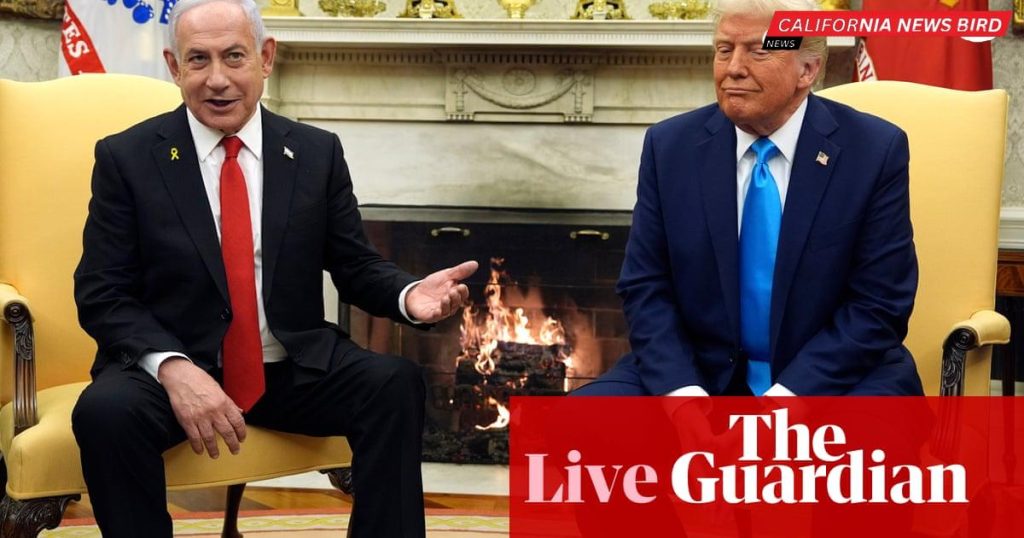/ Jul 08, 2025
Trending

In a recent meeting at the White House, President Donald Trump and Israeli Prime Minister Benjamin Netanyahu sparked intense debate over a proposed plan to permanently resettle all Palestinians from Gaza. Taking place on February 4, 2025, this controversial discussion included serious implications for the people living in Gaza and the wider Middle Eastern political landscape.
During their meeting, President Trump introduced a bold plan that suggested relocating all Palestinians currently living in Gaza to a new location. He described Gaza as a “demolition site” not suitable for habitation, which raised immediate concerns and criticisms from many, especially Hamas officials who condemned the proposal as leading to chaos. They believe displacing thousands of people would only escalate the region’s ongoing conflicts and worsen the humanitarian crisis.
The discussions between Trump and Netanyahu also highlighted a broader context of a fragile ceasefire between Israel and Hamas. While Netanyahu faces significant pressure from hard-line members of his coalition to take a stronger stance, these talks signal an ongoing effort to find a long-term resolution to the Gaza conflict. However, many other countries in the region have outright rejected Trump’s resettlement proposal, further complicating the situation.
Adding to the tension, President Trump signed executive orders that not only ended US funding for UNRWA, the United Nations Relief and Works Agency for Palestine Refugees, but also withdrew the United States from the UN Human Rights Council. These actions are significant as they reflect the changing approach of the US towards Palestinian support and humanitarian efforts. By cutting off financial aid, critics warn that the living conditions for Palestinians could deteriorate even further.
Trump’s call for the resettlement of Palestinians was met with strong disapproval from several Arab nations, including Egypt and Jordan, who have refused to consider the plan. This resistance highlights the sensitivity of the topic and will likely impact the relationships between these nations and the US moving forward. The intent behind the proposal is questionable, especially since it appears to shift responsibilities for Palestinian lives away from Israel, raising concerns about human rights and dignity.
As discussions continue, Trump’s administration faces criticism not only for its foreign policy but also for the feasibility of their strategies. Trump’s envoy remarked that a three to five year timeline for Gaza’s reconstruction is “preposterous,” indicating the significant challenges ahead. This becomes especially critical as any efforts toward rebuilding have to consider the ongoing blockade of the region and shortages of basic necessities.
Israeli Prime Minister Netanyahu’s leadership is under scrutiny as he navigates through domestic political challenges, including his ongoing corruption trial. The pressure from hard-line elements of his government could push him to advocate for stronger military actions in Gaza, complicating any efforts for peace. Yet, both leaders are aware that the future stability of the region heavily relies on finding a sustainable solution for the Palestinians in Gaza and the broader community.
This meeting between Trump and Netanyahu has opened the door to numerous questions about the future of Gaza and the people living there. As proposals are made and nations react, it remains to be seen what actions will follow and how they will affect life in Gaza and relations among countries in the region. With humanitarian concerns at the forefront, world attention focuses on these discussions hoping for a resolution that considers the dignity and rights of all parties involved.
In a recent meeting at the White House, President Donald Trump and Israeli Prime Minister Benjamin Netanyahu sparked intense debate over a proposed plan to permanently resettle all Palestinians from Gaza. Taking place on February 4, 2025, this controversial discussion included serious implications for the people living in Gaza and the wider Middle Eastern political landscape.
During their meeting, President Trump introduced a bold plan that suggested relocating all Palestinians currently living in Gaza to a new location. He described Gaza as a “demolition site” not suitable for habitation, which raised immediate concerns and criticisms from many, especially Hamas officials who condemned the proposal as leading to chaos. They believe displacing thousands of people would only escalate the region’s ongoing conflicts and worsen the humanitarian crisis.
The discussions between Trump and Netanyahu also highlighted a broader context of a fragile ceasefire between Israel and Hamas. While Netanyahu faces significant pressure from hard-line members of his coalition to take a stronger stance, these talks signal an ongoing effort to find a long-term resolution to the Gaza conflict. However, many other countries in the region have outright rejected Trump’s resettlement proposal, further complicating the situation.
Adding to the tension, President Trump signed executive orders that not only ended US funding for UNRWA, the United Nations Relief and Works Agency for Palestine Refugees, but also withdrew the United States from the UN Human Rights Council. These actions are significant as they reflect the changing approach of the US towards Palestinian support and humanitarian efforts. By cutting off financial aid, critics warn that the living conditions for Palestinians could deteriorate even further.
Trump’s call for the resettlement of Palestinians was met with strong disapproval from several Arab nations, including Egypt and Jordan, who have refused to consider the plan. This resistance highlights the sensitivity of the topic and will likely impact the relationships between these nations and the US moving forward. The intent behind the proposal is questionable, especially since it appears to shift responsibilities for Palestinian lives away from Israel, raising concerns about human rights and dignity.
As discussions continue, Trump’s administration faces criticism not only for its foreign policy but also for the feasibility of their strategies. Trump’s envoy remarked that a three to five year timeline for Gaza’s reconstruction is “preposterous,” indicating the significant challenges ahead. This becomes especially critical as any efforts toward rebuilding have to consider the ongoing blockade of the region and shortages of basic necessities.
Israeli Prime Minister Netanyahu’s leadership is under scrutiny as he navigates through domestic political challenges, including his ongoing corruption trial. The pressure from hard-line elements of his government could push him to advocate for stronger military actions in Gaza, complicating any efforts for peace. Yet, both leaders are aware that the future stability of the region heavily relies on finding a sustainable solution for the Palestinians in Gaza and the broader community.
This meeting between Trump and Netanyahu has opened the door to numerous questions about the future of Gaza and the people living there. As proposals are made and nations react, it remains to be seen what actions will follow and how they will affect life in Gaza and relations among countries in the region. With humanitarian concerns at the forefront, world attention focuses on these discussions hoping for a resolution that considers the dignity and rights of all parties involved.
It is a long established fact that a reader will be distracted by the readable content of a page when looking at its layout. The point of using Lorem Ipsum is that it has a more-or-less normal distribution of letters, as opposed to using ‘Content here, content here’, making it look like readable English. Many desktop publishing packages and web page editors now use Lorem Ipsum as their default model text, and a search for ‘lorem ipsum’ will uncover many web sites still in their infancy.
It is a long established fact that a reader will be distracted by the readable content of a page when looking at its layout. The point of using Lorem Ipsum is that it has a more-or-less normal distribution of letters, as opposed to using ‘Content here, content here’, making it look like readable English. Many desktop publishing packages and web page editors now use Lorem Ipsum as their default model text, and a search for ‘lorem ipsum’ will uncover many web sites still in their infancy.
The point of using Lorem Ipsum is that it has a more-or-less normal distribution of letters, as opposed to using ‘Content here, content here’, making

The point of using Lorem Ipsum is that it has a more-or-less normal distribution of letters, as opposed to using ‘Content here, content here’, making it look like readable English. Many desktop publishing packages and web page editors now use Lorem Ipsum as their default model text, and a search for ‘lorem ipsum’ will uncover many web sites still in their infancy.

The information provided by California News Bird is for general informational purposes only. While we strive to ensure that the content we publish is accurate, current, and reliable, we make no representations or warranties of any kind, express or implied, about the completeness, accuracy, reliability, or availability of the information, products, or services contained on our website.